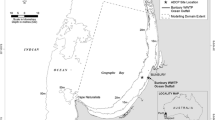Abstract
A method to evaluate aquatic mortality given a pollutant distribution is presented and applied to several sample low pH plumes representing various ocean CO2 disposal schemes. The method is an improvement over current analysis because it integrates the mortality due to time‐varying exposure to low pH with the probabilistic experiences of passive organisms subject to turbulent lateral diffusion as they pass through the plume. For the examples presented, the plume was discretized laterally into lanes and longitudinally by time steps, and a random walk model accounting for the scale‐dependent nature of relative diffusion was used to simulate the organism pathways over one time step. From these simulations, the probability that an organism will be in a given lane, \(\dot \jmath \), one time step after it starts from an initial lane, \(i\), was determined for all combinations of \(i\) and \(\dot \jmath \) . These probabilities were used to find the number of organisms following each of the possible pathways, and the mortality to the organisms due to their time varying exposure to low pH was determined by using the toxicity model described in part I of this paper. The integrated method allows the impact of the plume to be described in terms of total organism mortality as well as spatial deficit of organisms.
Similar content being viewed by others
References
E.E. Adams, D. Golomb, X.Y. Zhang and H.J. Herzog, Confined release of CO2 into shallow seawater, in: Direct Ocean Disposal of Carbon Dioxide, eds. N. Handa and T. Oshumi (Terra Scientific Publishing Company, Tokyo, 1995) pp. 153–164.
E.E. Adams and H.J. Herzog, Environmental impacts of ocean disposal of CO2, Report No. MIT-EL 96-003, MIT Energy Lab., Cambridge, MA (1996).
D.I. Auerbach, J.A. Caulfield, E.E. Adams and H.J. Herzog, Impact of ocean CO2 disposal on marine life: I. A toxicological assessment integrating constant-concentration laboratory assay data with variable-concentration field exposure, Environmental Modeling and Assessment 2 (1997), this issue.
N.H. Brooks, Diffusion of sewage effluent in an ocean current, in: Proc. 1st International Conference on Waste Disposal in the Marine Environment (Pergamon Press, 1960) pp. 246–267.
J.A. Caulfield, Environmental impacts of carbon dioxide ocean disposal: plume predictions and time dependent organism experience, M.S. thesis, Department of Civil and Environmental Engineering, MIT, Cambridge, MA (1996).
J.A. Caulfield, D.I. Auerbach, E.E. Adams and H.J. Herzog, Near-field impact of reduced pH from ocean CO2 disposal, Energy Conversion and Management 38(Suppl.) (1997) S343–S348.
P. Colinvaux, Ecology, 2nd edn. (Wiley, New York, (1986).
H. Drange and P.M. Haugan, Carbon dioxide sequestration in the ocean: the possibility of injection in shallow water, Energy Conversion and Management 33 (1992) 697–704.
A.D. Jenkins, Simulation of turbulent diffusion using a simple random model of the flow field, Applied Mathematical Modeling 9 (1985) 239–245.
G.H. Jirka, J.M. Jones and F.E. Sargent, Theoretical and experimental study of the intermediate field dynamics of ocean thermal energy conversion plants, Technical Report, Cornell University, Ithica, NY (1980).
O. Kinne, Marine Ecology: A Comprehensive Integrated Treatise on Life in Oceans and Coastal Waters, Vol. 4 (Wiley-Interscience, New York, 1978).
J.R. Ledwell and A.J. Watson, Evidence for slow mixing across the pycnoline from an open-ocean tracer-release experiment, Nature 364 (1993) 701–703.
C.R. Liro, E.E. Adams and H.J. Herzog, Modeling the release of CO2 in the deep ocean, Energy Conversion and Management 33 (1992) 667–674.
A. Okubo, Oceanic diffusion diagrams, Deep-Sea Research 18 (1971) 789–802.
R.A. Paddock and J.D. Ditmars, Initial screening of license applications for ocean thermal energy conversion OTEC plants with regard to their interaction with the environment, Technical Report ANL/OTEC-EV-2, Argonne National Laboratory (1983).
L.F. Richardson, Atmospheric diffusion shown on a distance neighbour graph, Proc. Roy. Soc. London, Ser. A 110 (1926) 709–737.
D.C. Rose, G.W. Williams, T.A. Hollister and P.R. Parrish, Method for determining acute toxicity of an acid wasted and listing permissible concentration at boundaries of an oceanic mixing zone, Environmental Science and Technology 11(4) (1977) 367–371.
H. Stommel, Horizontal diffusion due to oceanic turbulence, Journal of Marine Research VIII (1949) 199–225.
I. Valiela, Marine Ecological Processes (Springer, New York, 1984).
K.A. van Scoy, Tracer release experiments: Applications in ocean physics and chemistry experiments, in: Ocean Storage of Carbon Dioxide 1: Ocean Circulation, ed. B. Omerod, IEA Greenhouse Gas R&D Programme, Cheltenham, UK (1996).
Author information
Authors and Affiliations
Rights and permissions
About this article
Cite this article
Caulfield, J.A., Adams, E.E., Auerbach, D.I. et al. Impacts of ocean CO2 disposal on marine life: II. Probabilistic plume exposure model used with a time‐varying dose‐response analysis. Environmental Modeling & Assessment 2, 345–353 (1997). https://doi.org/10.1023/A:1019081915826
Issue Date:
DOI: https://doi.org/10.1023/A:1019081915826




